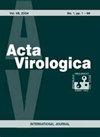SARS-CoV-2对易感人体细胞的影响
IF 0.8
4区 医学
Q4 VIROLOGY
引用次数: 0
摘要
病毒感染的生物学后果是由受感染细胞的生化、生理、结构、形态和遗传变化引起的。在生产性感染中,病毒诱导的细胞生物学变化可能与病毒复制的效率或免疫系统对这些细胞的识别密切相关。这些变化通常与杀细胞病毒有关,例如导致COVID-19的大流行冠状病毒SARS-CoV-2。许多这些变化是有效的病毒复制所必需的。活细胞的生理状态对病毒感染的结果有重要影响,因为宿主细胞为新合成的病毒蛋白和核酸提供了合成机制、关键调节分子和前体。本文综述了SARS-CoV-2在呼吸道外暴露的新靶细胞类型。收集了提供病毒-细胞相互作用信息的发现和例子。SARS-CoV-2异常靶细胞的鉴定可能有助于解释COVID-19患者的不同症状以及感染后的长期影响。特别是,需要考虑发现以前未描述的SARS-CoV-2作用的靶细胞,以改善患者的治疗和预防感染。本文章由计算机程序翻译,如有差异,请以英文原文为准。
The effects of SARS-CoV-2 on susceptible human cells
The biological consequences of viral infection result from biochemical, physiological, structural, morphological and genetic changes in infected cells. In productive infections, virus-induced biological changes in cells may be closely related to the efficiency of viral replication or to the recognition of these cells by the immune system. These changes are usually associated with cytocidal viruses, as in the case of the pandemic coronavirus SARS-CoV-2, which causes COVID-19. Many of these changes are required for effective viral replication. The physiological state of living cells has a significant impact on the outcome of viral infection, as the host cell provides the synthetic machinery, key regulatory molecules and precursors for newly synthesised viral proteins and nucleic acids. This review focuses on novel target cell types for SARS-CoV-2 exposure outside the respiratory tract. Findings and examples are collected that provide information on virus-cell interactions. The identification of unusual target cells for SARS-CoV-2 may help to explain the diverse symptoms in COVID-19 patients and the long-lasting effects after infection. In particular, the discovery of previously undescribed target cells for SARS-CoV-2 action needs to be considered to improve treatment of patients and prevention of infection.
求助全文
通过发布文献求助,成功后即可免费获取论文全文。
去求助
来源期刊

Acta virologica
医学-病毒学
CiteScore
3.10
自引率
11.80%
发文量
43
审稿时长
>12 weeks
期刊介绍:
Acta virologica is an international journal of predominantly molecular and cellular virology. Acta virologica aims to publish papers reporting original results of fundamental and applied research mainly on human, animal and plant viruses at cellular and molecular level. As a matter of tradition, also rickettsiae are included. Areas of interest are virus structure and morphology, molecular biology of virus-cell interactions, molecular genetics of viruses, pathogenesis of viral diseases, viral immunology, vaccines, antiviral drugs and viral diagnostics.
 求助内容:
求助内容: 应助结果提醒方式:
应助结果提醒方式:


